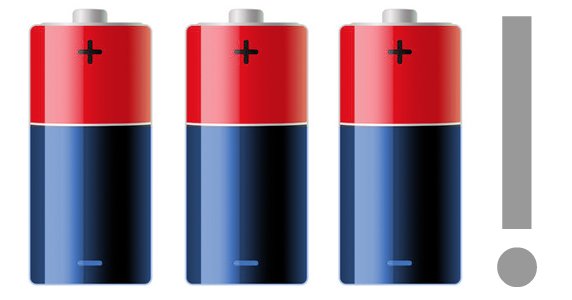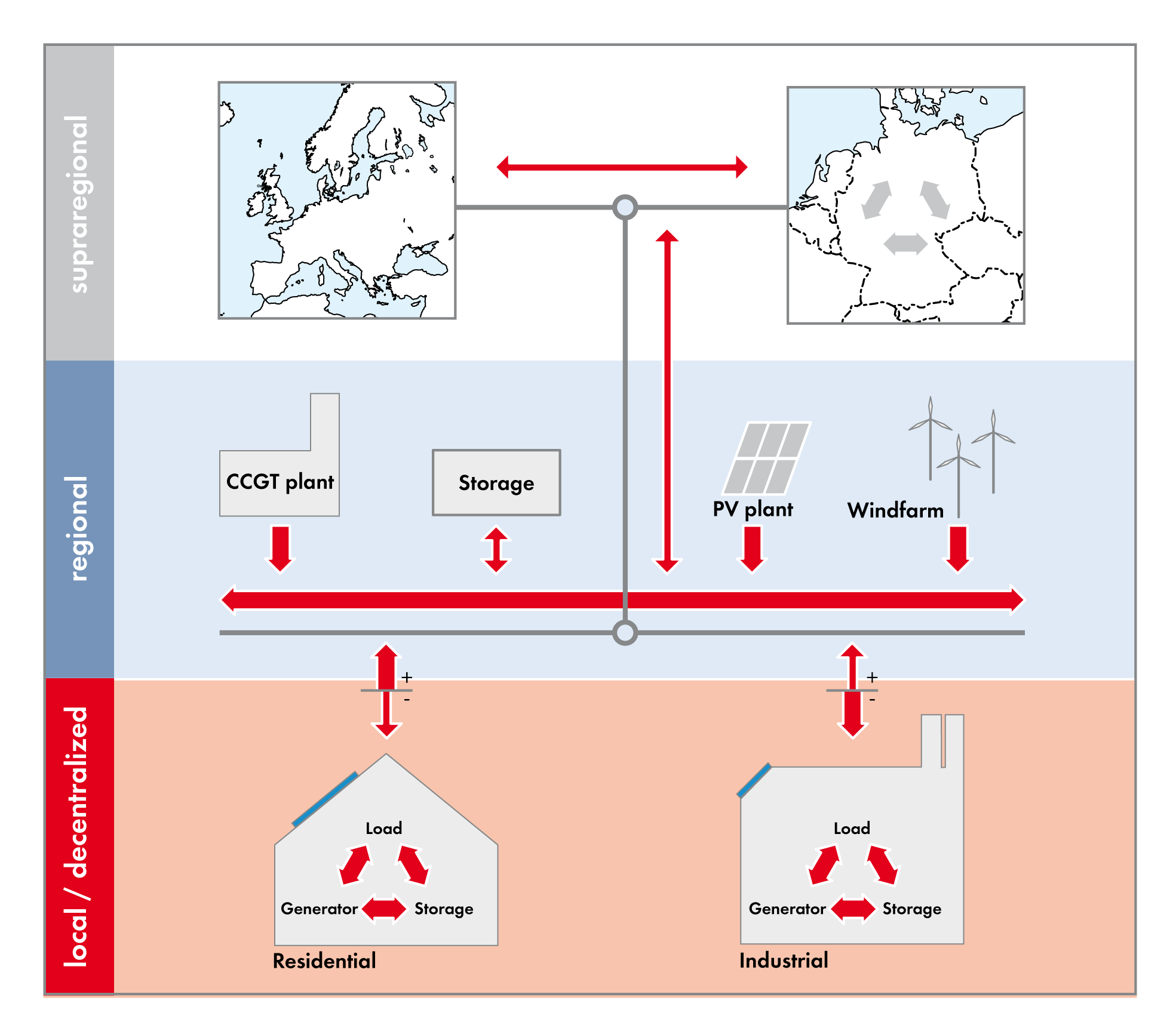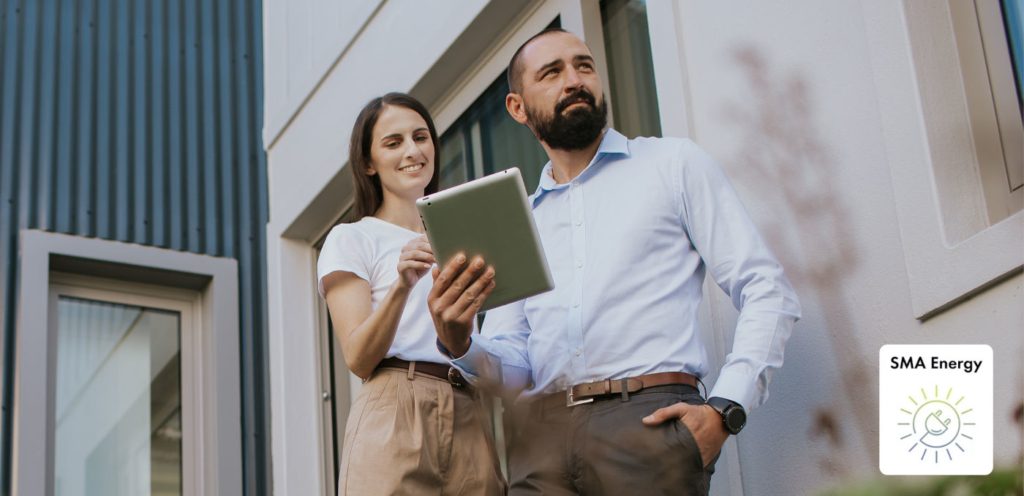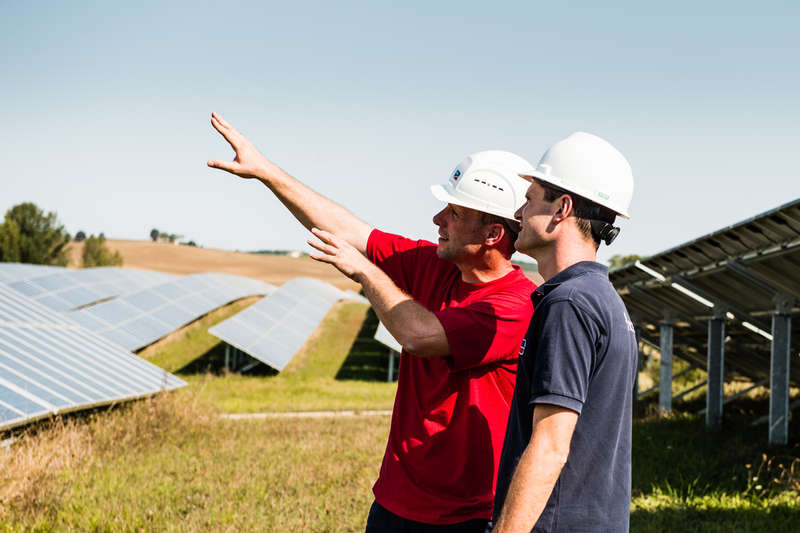Decentralized Battery Storage as a Solution

Storage systems can help increase self-consumption and relieve the power distribution grid with decentralized systems offering numerous advantages.
It is hard to deny the major role that photovoltaics have played in furthering the energy revolution. In June 2011, all PV plants in Germany combined, generated enough power to meet peak demand at midday hours while maintaining an almost constant baseload. Despite good correlation in time and the excellent predictability of solar energy, the question arises as to how additional PV power can be added to the power distribution grid. Even today one can check daily statistics on the EXX transparency platform and often see slight midday troughs and morning and evening increases in the conventional power supply.
To avoid greater fluctuations in the conventional power supply when installing additional PV capacity, the intermediate storage of solar power is essential. Intermediate storage also reduces the distribution grid load by limiting peak power generation and consumption and helps lower system expansion needs. The range of uses for intermediate storage is nowhere near exhausted. Decentralized storage systems can increase self-sufficiency and improve supply security with a backup electricity supply while providing the technical basis for future grid services. In short, decentralized storage systems are the key to converting the electricity supply into a smart-grid based on renewables.
Advantages of decentralized energy storage
The fluctuating power generation capacity using renewable energy needs to be balanced on all levels, from international, national and regional power distribution grids to the household grids of private and commercial plant operators (Fig. 1). This requires the ability to not only store energy on a temporary basis, but also load management and feed-in management. In all three cases there are excellent reasons why local, decentralized applications represent the best solution: In Germany, more than 70 percent of PV power comes from smaller PV systems feeding into the low-voltage grid. As this is the same voltage level where the majority of power is consumed, a decentralized balancing of power can benefit from short distances between the power generator, load and storage system and therefore minimize transmission losses and grid load.

Fig. 1: The future electricity supply model: Power balancing on all levels while being as decentralized as possible.
In terms of viable battery types, there are no significant economies of scale that can make more largely dimensioned batteries cheaper and more efficient. Batteries basically consist of smaller battery cells which are just combined to achieve the desired storage capacity. Decentralized storage also offers a remarkable expansion dynamics: As the example of installed PV capacity clearly shows, significant range can be added very quickly using small, privately-financed and adequately subsidized units, since this kind of investment does not depend on business models and investors. In contrast to distribution grid operators, private homeowners have a real incentive to use storage systems. These systems not only allow greater independence from energy providers and ensure a fail-safe electricity supply, they also offer real financial incentives through an increase in self-consumption and the use of time-variable feed-in tariffs. Distribution grid operators do not have a business model for operating local power storage systems. In fact, current laws actually make it illegal for them to operate storage systems. They also have to contend with longer planning and certification periods as well as the financial constraints resulting from not having a business model. Therefore, there are many good reasons to focus on decentralized storage systems for domestic use.
No increase in grid load with storage-assisted self-consumption
Storage systems currently on the market focus on increasing the self-consumption rate which is beneficial for two reasons: First, the self-consumption of solar power lowers the effective feed-in capacity and thus the load on the distribution grid. Second, self-consumption increases the economic yield of PV plants despite the ever rising electricity prices. In particular, when considering the proposed subsidy cuts with the feed-in compensation stipulated in the German Renewable Energy Sources Act, which is limited to 80 percent of generated kilowatt hours, self-consumption is now more critical than ever to achieving profitability. (Editor’s note: According to the final EEG amendment, a maximum of 90 percent of the annually generated kWh is compensated, effective as of January 1, 2014)
Smart energy management and storage systems make it possible to actually increase the rate of self-consumption by a significant degree. Yet for some time now there has been a concern that an increased self-consumption using storage systems could cause an additional burden for the power distribution grid. The line of argument: Due to the economic viability, most of the installed storage systems would have a quite small storage capacity. Therefore, under good weather conditions, they would be fully charged even before the midday hours of peak power generation. In that moment, all these PV plants would feed straight into the power distribution grid, causing a sudden power surge.
This scenario however leaves out a few important aspects. The geographical distribution of PV plants (at different longitudes and under different weather condition) as well as different PV array alignments, PV power ratings and storage capacities help counter this simultaneous effect. Another aspect ignored involves the charging characteristics of common storage systems: With the storage systems currently available, the charging current does not suddenly drop to zero when the battery is full. Instead, a charging algorithm ensures relatively smooth control over the charging current. And unlike the solar irradiation, the charging and discharging power can be regulated at any time to prevent power spikes. Another fact that counters the fear of massive power spikes is that only a relatively small of storage power is needed to make increased self-consumption economically viable, not at least due to the power-dependent efficiency of the battery. For this reason, even a sudden interruption in the charging process would not normally cause a power spike on the level of maximum PV power. In fact, switching large household appliances on and off usually has a much greater effect.
SMA field test confirms grid relief
This assessment was confirmed by a field test that SMA carried out, collecting operating data from 10 PV plants with grid-connected storage systems over a period of 12 months. Since the effect of the storage system is easy to calculate, the relevant comparison values are also provided. The result: No performance data recorded from any PV plant, on any day, indicated higher grid exchange capacity caused by the storage system. Actually the opposite was shown: Given constant maximum values, the average rates of change in the grid exchange capacity actually went down by a significant degree in all cases. In the system with the smallest PV peak power, the rate decreased by about 26 percent, and this despite an operational control designed for maximum self-consumption. Figure 2 and 3 show the power generation and consumption values for a four-person home with a 5.6 kWp PV power plant – both without and with a storage system included.
Apart from the greatly reduced grid feed-in that intermediate storage of solar power results in, it is easy to see that large fluctuations in the grid exchange capacity are caused primarily by the activation of heavy loads and not by the 2.2 kW storage system. Yet the overall grid exchange capacity decreases, which is reflected in the aforementioned annual averages.

Fig. 3: The same situation with a storage system for increased self-consumption: The amount of PV energy fed to the grid drops significantly; it does not increase the load on the power distribution grid.
Additional grid relief through intelligent power storage
With an operational control system designed to reduce grid load, this positive effect can actually be amplified. It is conceivable, for example, to configure a storage system for “peak shaving”, which means that any peak power not concurrently balanced by corresponding loads will be absorbed by the battery to maintain a specific feed-in capacity. In the opposite case, the storage system limits the amount of power drawn from the power distribution grid by providing additional power when needed. Figure 4 demonstrates this operating method based on real power generation and consumption values from the SMA field test. The battery is now charged when the feed-in capacity exceeds 1.9 kW and can therefore buffer power spikes over the entire period of power generation. Compared to conventional storage systems with an identical increase in self-consumption, this simple additional rule leads to a significant reduction in the grid exchange capacity and much smaller maximum values.

Fig. 4: Option with simulated storage model for maximum grid relief: Despite the same storage capacity and power, the maximum value and grid exchange capacity decrease.
The graphic clearly shows the enormous potential that decentralized smart storage systems have for relieving the power distribution grid. To realize that potential, however, a reliable forecast of PV power generation is necessary to ensure that the battery can fully charge even under irregular irradiation conditions. Of almost equal importance is information on the expected home load profile and an accurate measurement of power consumption, as any consumption that occurs while PV power is being generated reduces the grid exchange capacity and hence the need for storage. The ability to measure power at small time intervals is critical for regulating fast pulsing loads such as electric stoves.
The ideal solution is therefore a storage system that is part of a decentralized, smart energy management system such as the new Sunny Home Manager from SMA. This device is not only able to estimate power generation and loads, but also can record all relevant energy flows in a home via three S0- and D0-meter interfaces. Furthermore it is able to automatically control the operating times of individual loads in order to optimize the self-consumption rate. Based on the above energy management system, decentralized storage systems can significantly reduce grid load while increasing self-consumption, self-sufficiency and security of supply.
Explanation of diagrams
- Energy consumption at home equals the sum of all gray, green and orange areas (purchased electricity + direct self-consumption + energy drawn from the battery).
- The gray areas also correspond to the areas bordering positive grid exchange capacity.
- The blue areas correspond to the energy fed to the power distribution grid as well as the area bordering the negative
grid exchange capacity. - The yellow and orange areas correspond to the amount of energy stored in and discharged from the battery.
Reading example for Fig. 4:
Between 9 a.m. and 10 a.m. there is about 3 kW of power generation capacity but only about 700 W of self-consumption
capacity. This widening difference in capacity is absorbed by the storage system (yellow area) to make sure that grid feed-in
(red curve) does not exceed the 1.9 kW limiting value.
After 10 a.m. demand exceeds PV power generation, which, as a result, is entirely self-consumed (green area). Any additional
power that is needed is not drawn from the power distribution grid but instead from the storage system (orange area), which
means the grid exchange capacity remains zero.
Only between 11:30 a.m and 2 p.m will the feed-in capacity exceed the 1.9 kW threshold since the maximum power of the
2.2 kW storage system is unable to bridge the difference between power generation and consumption. After 2 p.m power
consumption continues to increase steadily and as a result the feed-in capacity remains below 1.9 kW, even without power
storage.
At around 8 a.m. and 5 p.m. power consumption exceeds the sum of self-consumption and maximum storage capacity,
which is the reason for the “gray peaks” at those times. The remaining power needed is therefore drawn from the power
distribution grid, which is also shown by the spikes in grid exchange capacity.





This looks excellent, where can I buy one? Would this work with the SunnyBoy 2000HF-30 using Bluetooth?
Kind regards
Dear Seth,
thank you for your comment. We will talk to our Sunny Boy communication experts and will get back to you as soon as possible.
Regards,
Jannis
Dear Seth,
Thank you for your comment and question.
Here’s the answer of my colleague:
The Sunny Backup should be available by any distributor that sells SMA inverter. Please note that Sunny Backup 2200 is only certified in Germany and Sunny Backup 5000 is certified in Germany and Australia.
The Sunny Boy 2000 HF-30 is not recommended for the use in a Sunny Backup system.
We recommend the following devices :
In case of Plants without PV array pole grounding: Sunny Boy 2100TL or Sunny Boy 2500TL Single Tracker.
In case of Plants with pole-grounding or requiring transformer inverters: Sunny Boy 2500
Best wishes
Leonie
Thank you for your interesting story. Yes i believe the decentralisation of energy generation through PV combined with small local storage systems are the solution for the rising energy need and costs of today. We have just installed a 4500kWp PV installation, and are interested in these solutions. However to calculate the affordability for a domestic household the local (in our case NL) government subsidy needs to be taken in account. Will a private household be interested? Plse inform us about the costs of such a system. Best regards;